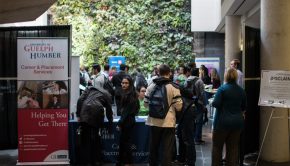Let’s take a walk
The people behind the vest
They roam the campus: a streak of red in the corner of the eye that goes un-noticed, unless they are needed. The Campus Walk program has over 40 students volunteering, and they all have their own story to tell.
Nine people are gathered around a boardroom table, four Campus Walk volunteers donned in bright red vests, and their supervisors. Their goal at this particular meeting: diving into the life of a Campus Walk volunteer.
They are all part of Campus Walk for different reasons. Matthew Allen is a volunteer that came from a small town, so he was drawn to the program to find a sense of community.
“When I found Campus Walk I started thinking, when you see these people patrolling and helping you feel safer, it helps build a sense of inclusion for yourself as student,” he says, “so I think that facilitates a very important role for us on campus, not just an extra eye for security, but as community builders.”
The volunteers at the table agree that the program has given the opportunity to reach out to their fellow students. A volunteer named Jennifer Flood says her being a student is a factor in the success of the program.
“We’re all in the same age group, it’s not like you’re reaching out to someone older and they’re going to judge you. You understand what everyone’s going through because we’re all on the same page,” she says.
Campus Walk’s Co-ordinator Christopher Duvall says the program is made up of 95 per cent justice studies students this year.
“They have helper personalities,” says Nancy Deason, the program’s manager, as her eyes scan the faces in the room. “Going into those programs of justice or policing you have that personality as part of you, that you’re a helper and you are concerned for others. That leads well into this program.”
The program runs all school year, from noon to midnight on most weekdays. The student volunteers around the table work day shifts. They say on a shift from 3 p.m. to 6 p.m. they can usually expect one or two calls, so they have plenty of time to patrol the school offering their services.
“A lot of students ask directions, we’ll see people walking around franticly [trying to find something]” says Flood, “We’ll walk them there instead of trying to explain it. We’ve had really good feedback about it.”
The volunteers have helped plenty of lost students, and Duvall says he’s had the experience himself.
“My first shift I was with a friend, and we thought hey, we’re part of public safety now, we’re allowed to go essentially anywhere we want. It was a free card to the school so we were like let’s explore…we got so lost,” he says, as the rest of the table starts to laugh, “we didn’t know what the ten code was for ‘can you come find us and help us out’. So we just wandered probably for an hour and a half until we found a door leading outside.”
When he says “10-code” it refers to the codes used by the entire security team. Each has its own meaning, and the campus walk volunteers hear all of the radio chatter around campus. When they get the 10-12 code it means someone wants a walk.
“At first those ten codes are really daunting, because there are like 50 of them. Just by listening to the radio you pick them up,” says Duvall, “That was the thing I was most proud of learning.”
The volunteers all say that the codes were a unique learning experience. One of the volunteers, Karla Acevedo, says her first day with the radio was handled very carefully.
“Before I even said anything in the radio, I went through it like five times in my head,” she says with a laugh, “then I pressed the button and totally chickened out and just let it go. I was like, k wait, practice again so you can get it right.”
All the volunteers are comfortable with the codes now, so when they hear a 10-12 they don’t panic, they just get enthusiastic.
“I get excited” says Flood, with a “me too!” from Acevedo.
“It’s like yay someone to walk with,” says Flood continuing, just as Robert Kilfoyle, director public safety, leans forward to say “something to do!” with laughs following from the rest of the volunteers.
“I guess you get a bit of adrenaline going,” says Flood, “but it’s good and I like it.”
When the volunteers go out for a walk, they say that customer service comes into play a lot.
“I’m a quieter person, so having customer service skills is important,” says Jordan Munro, a volunteer. “Sometimes they’ll be like ‘what are you gonna do if someone comes up to me’ and I just say we work in groups so that is helpful and we have security guards to call on our radios.”
Deason says it’s more important that the volunteers are respectful than big and strong.
“The theory is safety in numbers,” she says, “we’re not here to be body guards, we’re here to make people feel comfortable. We always go in at least pairs of two.”
If a problem ever does arise while on a walk, the volunteers say they would first use their quick access to security over their radios. Munroe says they also have training that deals with stressful situations.
“We have non-violent crisis intervention training, so basically you learn how to handle different conflict situations. There’s a self-defence portion of it, but it just helps you to communicate more efficiently.”
When students volunteer to join the Campus Walk program they have to go through about four to eight hours of training. Afterwards if they still want to volunteer and there’s room available, they could be walking around campus in a red vest by the next week.
“My first day of placement last year, we were asked to assist in a police investigation, and that was very cool,” says Allen, “We were just providing extra eyes and ears but I think we had nine Campus Walkers fresh out of winter break.”
“-and you thought it was going to be like that all the time,” says Deason with a smile.
Deason has been around since the program started in 1992, about 20 years ago. When asked what the volunteers would remember 20 years into the future Duvall says:
“It’s the people. In 20 years’ time we’ll forget the training, we’ll forget all the little issues we had to deal with, we’ll even probably forget most of our education, but I think the people we met during it, and the interactions we shared with them are the things we’ll hold onto for a while.”
The statement is met with nods and hums of agreement from the rest of the volunteers.
Viktor Runov, the marketing coordinator who has been sitting in, says “it’s all those little adventures.”
“I’ve made a lot of good friends on Campus Walk,” says Flood, “and it’s something good to put on your resume.”
The volunteers say the experience will affect them later in life, even when it comes to their careers.
“I think one of the most important things Campus Walk does is build a foundation of solid characteristics for your future,” says Runov.
Flood says the program has sparked an interest in security work.
“I was never really interested in policing, but this showed me that even security could be an option,” she says, “I never thought I would actually want to be a security guard, but this showed me that it’s something that interests me, and I actually really enjoy doing it.”
Over the next few years, the volunteers say they want to continue to volunteer with Campus Walk as much as their schedules allow it.
“Assuming they want me back, I’m going to be here next year,” says Allen.





